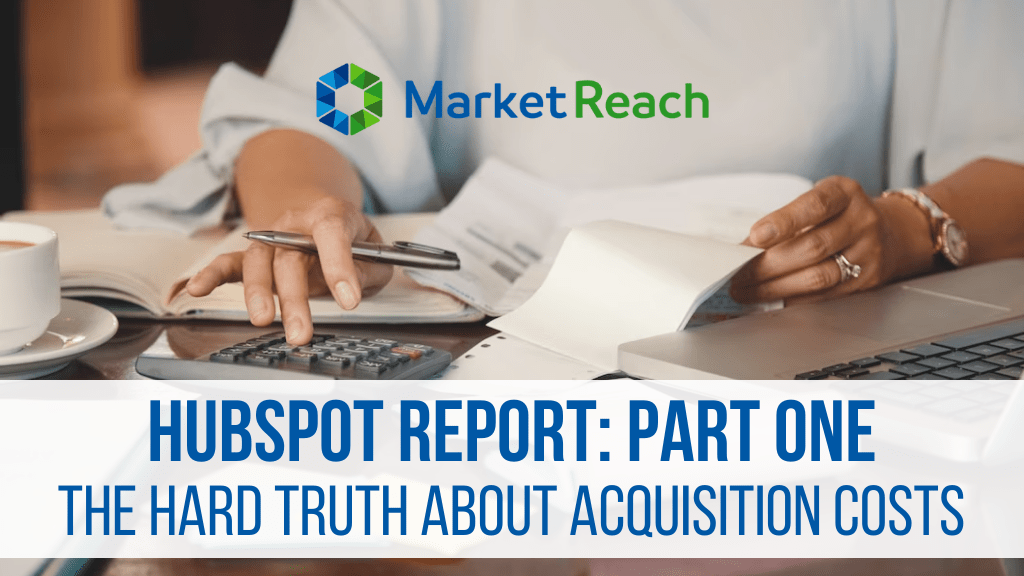
Hubspot Report: Part One – The Hard Truth About Acquisition Costs (and How Your Customers Can Save You)
 Excerpt taken from Report Published by Hubspot
Excerpt taken from Report Published by Hubspot
VIEW FULL REPORT HERE
May 9, 2018 // 4:00 PM
Michael Redbord
Consumers don’t trust businesses anymore
The way people interact with businesses has changed — again. The internet’s rise three decades ago did more to change the landscape of business than anyone could have imagined in the 1990s. And now it’s happening again.
Rapid spread of misinformation, concerns over how online businesses collect and use personal data, and a deluge of branded content all contribute to a fundamental shift — we just don’t trust businesses anymore.

- 81% trust their friends and family’s advice over advice from a business
- 55% no longer trust the companies they buy from as much as they used to
- 65% do not trust company press releases
- 69% do not trust advertisements, and 71% do not trust sponsored ads on social networks
We used to trust salespeople, seek out company case studies, and ask companies to send us their customer references. But not anymore. Today, we trust friends, family, colleagues, and look to third-party review sites like Yelp, G2Crowd, and Glassdoor to help us choose the businesses we patronize, the software we buy, and even the places we work.
Consumers are also becoming more impatient, more demanding, and more independent.

In a survey of 1,000 consumers in the United States, United Kingdom, Australia, and Singapore, we found that 82% rated an immediate response as “important” or “very important” when they were looking to buy from a company, speak with a salesperson, or ask a question about a product or service. That number rises to 90% when looking for customer service support.
But what does “immediate” mean? Over half (59%) of buyers expect a response within 30 minutes when they want to learn more about a business’ product or service. That number rises to 72% when they’re looking for customer support and 75% when they want to speak with a salesperson.
Modern consumers are also unafraid to tell the world what they think. Nearly half (49%) reported sharing an experience they had with a company on social media, good or bad. While buyers are fairly even split between being more likely to share a good experience (49%) vs. a bad one (51%), every customer interaction you have is an opportunity to generate buzz — or risk public shaming.
The hard truth is that your customers need you a lot less than they used to. They learn from friends, not salespeople. They trust other customers, not marketers. They’d rather help themselves than call you.
Acquisition is getting harder
The erosion of consumer trust is a difficult issue for companies to grapple with on its own. But as if that wasn’t enough, the internet, which has always fundamentally transformed the traditional go-to-market strategy, is moving the goalposts again.
Let’s break this down into two functions: Marketing and sales.
Marketing is getting more expensive
We’ve taught inbound marketing to tens of thousands of companies and built software to help them execute it. Inbound marketing accelerated business growth through a repeatable formula: Create a website, create search-optimized content that points to gated content, then use prospects’ contact information to nurture them to a point of purchase.
This still works — but the market is experiencing four trends that, combined, have made it harder for growing businesses to compete with long-established, better-resourced companies.
Trend 1: Google is taking back its own real estate
Much of modern marketing is dependent on getting found online. Without the multimillion-dollar brand awareness and advertising budgets of consumer goods titans, the best way a growing business can compete is creating content specific to their niche and optimizing it for search.
Google, the arbiter of online content discoverability, has made significant changes in the last few years that make it harder for marketers to run this model at scale without a financial investment.
First, through featured snippets and “People Also Ask” boxes, Google is reclaiming its own traffic.
A featured snippet is a snippet of text that Google serves on the search engine results page (SERP). You’ve likely been served a featured snippet when you were searching for a definition, or something that involved a step-by-step explanation.
Here’s an example of a featured snippet. It’s designed to pull information onto the SERP itself so there’s no need to click into the full recipe, hosted on another website.

“People also ask” boxes are a different permutation of a featured snippet. These display questions related to your original search, live on the SERP, and are expandable with a click, like so:

Each time you expand a “People Also Ask” section, Google adds 2-4 queries to the end of the list.
The combined effect of featured snippets and “People Also Ask” boxes? It depends. If your site is the first result and gets featured in the snippet, your traffic should increase. But if you don’t win the featured snippet, even if your post is ranked at position 1, it’s likely your overall traffic will decrease.
Second, Google’s also changed its search engine results page (SERP), moving search ads from a sidebar to the top four slots. Organic results fall much further down the page, and on a mobile device they disappear entirely.
Search won’t ever become purely pay-to-play. But in a world where screen real estate is increasingly dominated by sponsored content, marketers need to factor paid tactics into any organic strategy.
Voice search adds a third wrinkle to these shifts — the winner-take-all market. As the use of voice search has proliferated, it’s become more and more important to become the answer, as voice assistants only provide one result when asked a question.
On Google, featured snippets demonstrate this necessity. Amazon has also introduced “Amazon’s Choice” products, the first items suggested when consumers order items via voice assistant. It’s not hard to imagine a future where all Amazon’s Choice products are also Amazon-branded, manufactured, and distributed.
Trend 2: Social media sites are walled gardens
A decade ago, social media sites were promotion channels that served as a path between users and the poster’s site. The borders between different sites were fluid — people would discover content on Facebook, Twitter, and LinkedIn, then click through to content (usually hosted on another site).
Today, social media sites are walled gardens. Algorithms have been rewritten to favor onsite content created specifically for that platform. Facebook Messenger and evolving paid tools like Lead Ads are becoming a table-stakes marketing channel, meaning businesses can’t just “be on Facebook” — they must recreate their marketing motion in a second place.
Facebook and LinkedIn have also deprioritized showing content that links offsite in favor of family and friends’ content (on Facebook) and onsite video and text (on LinkedIn). Not only does your branded content have a harder time competing with other brands, it will also have to compete for attention with your prospects’ personal network. Twitter’s investment in streaming video partnerships with entertainment and news networks are a nod to bringing consumers content they’d watch anyway in a platform-owned experience.
Sites like Amazon and Facebook are also becoming starting points for search. Over half of product searches (52%) begin on Amazon, while 48% of searches for content originate on Facebook — almost equivalent to Google’s reach (52%). And both Amazon and Facebook sell targeted advertising space.

Why is any of this important?
These algorithm changes reflect the desire companies have to keep the audiences they own, on their own sites. As long as they can monetize their traffic, they have no incentive to move back to the old passthrough model.
Increasingly, Facebook is a destination. Twitter is a destination. LinkedIn is a destination. It’s no longer enough to create a piece of content for your own site, then schedule out promotion across channels that point back to that content.
Savvy marketers know their ideas must be channel-agnostic and channel-specific at the same time. To get the most mileage out of a piece of content, its core concept must perform well across multiple channels, but marketers have to do more upfront work to create separate versions of this content to best suit the channel on which it’s appearing.
Trend 3: It’s getting more expensive to do marketing
Search and social media titans have moved their goalposts to create a more competitive content discovery landscape. At the same time, barriers to entry on these platforms are getting higher in two ways:
1. Organic acquisition costs are rising.
According to ProfitWell, overall customer acquisition costs (CAC) have been steadily rising for B2B and B2C companies.
Over the last five years, overall CAC has risen almost 50% — and while paid CAC is still higher than content marketing (organic) CAC, organic costs are rising at a faster rate.
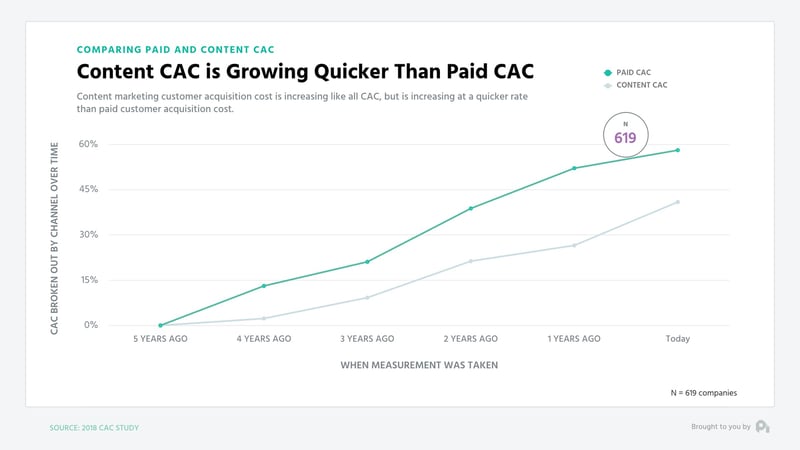
2. Content marketers are commanding higher salaries.
It’s not only harder to get value from content, it’s getting more expensive to create it. ProfitWell’s study examined the rise of content marketers’ salaries by location — median salary has risen 24.9% in metropolitan areas and 18.9% for remote workers in the last five years.
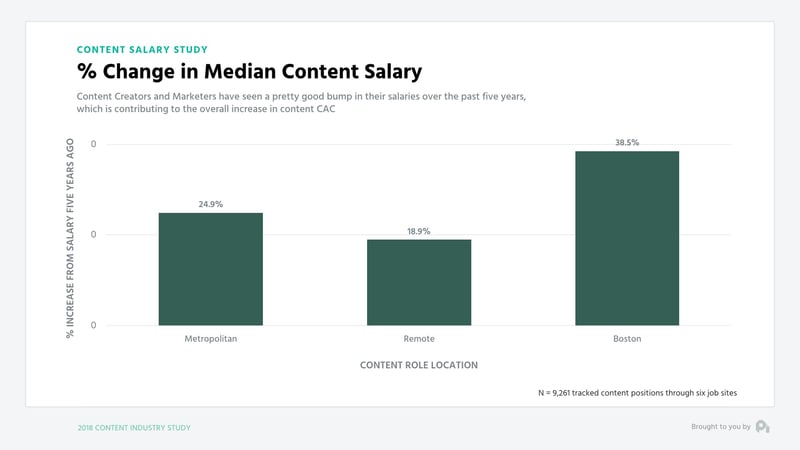
This rise is partially explained by changes in the content marketing profession. Google’s changing algorithm requires more specialized knowledge than ever. Not only are there specific optimization best practices to win featured snippets, Google’s current algorithmic model favors sites that are architected using the topic cluster model. Depending on the size of your site, this can be a massive undertaking — at HubSpot, it took us over six months to fully organize our blog content by this model.
Trend 4: GDPR
The following is not legal advice for your company to use in complying with EU data privacy laws like the GDPR. Instead, it provides background information to help you better understand the GDPR. This legal information is not the same as legal advice, where an attorney applies the law to your specific circumstances, so we insist that you consult an attorney if you’d like advice on your interpretation of this information or its accuracy. In a nutshell, you may not rely on this as legal advice, or as a recommendation of any particular legal understanding.
The General Data Protection Regulation recently passed by the European Union (EU) imposes new regulations on how businesses are allowed to obtain, store, manage, or process personal data of EU citizens.
At a high level, here’s what GDPR means for marketing teams:
- Businesses collecting prospect data must explicitly state how that data will be used, and may only collect what’s necessary for that stated purpose
- Businesses may only use that data for the specified purposes above, and ensure it’s stored according to GDPR provisions
- Businesses may only keep personal data for as long as is necessary to fulfill the intended purpose of collection
- EU citizens may request that businesses delete their personal data at any time, and businesses must comply
GDPR doesn’t go into effect until May 25, 2018, so it’s hard to predict the exact impact it will have on lead generation and collection. But we feel confident that GDPR is the first step toward more regulation of how businesses interact with consumers globally, further limiting your marketing team’s power.
In combination, these four trends mean that:
- It’s harder to stand out in a crowded internet
- It’s more expensive to find talent and produce content
- Algorithmic changes will force investment in a multichannel marketing strategy
So it’s getting harder to get prospects to your site. But once you get them in the door, it should be standard operating procedure to getting those deals closed, right? Turns out … not quite.
Sales is getting harder, too
Every year, HubSpot surveys thousands of marketers and salespeople to identify the primary trends and challenges they face. And year after year, salespeople report that their jobs are becoming more difficult.
Consider this chart (a preview of State of Inbound 2018).
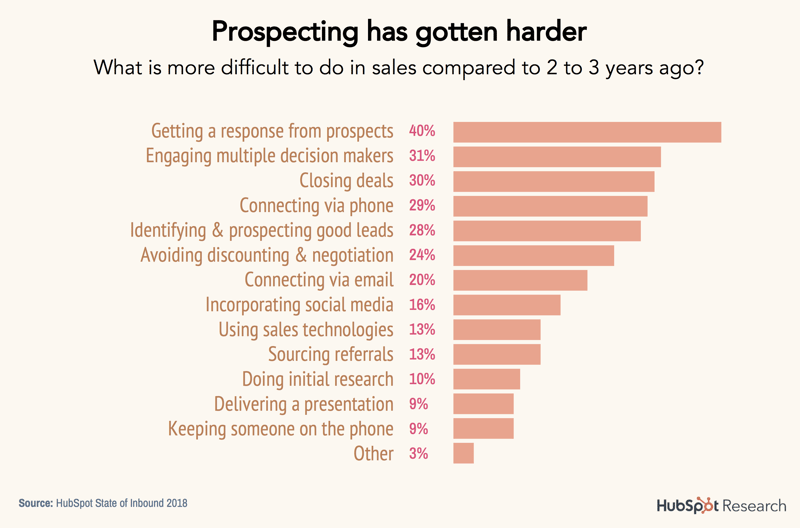
A whopping 40% of respondents reported that getting a response from prospects has gotten harder, while 29% and 28% respectively identify phone connections and prospecting as pain points.
Almost a third (31%) have to engage with multiple decision makers to move a single deal forward, and just as many find it difficult to close those deals.
Salespeople have to overcome an additional challenge on top of these sobering statistics: They aren’t trusted. Year over year, consumers report that salespeople are their least trusted source of information when making purchase decisions.
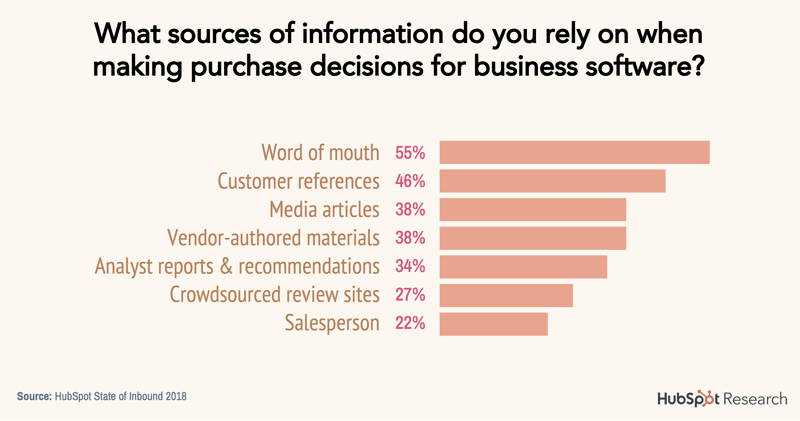
And even when there’s no purchase decision being made, salespeople don’t have a great reputation. A 2016 HubSpot study found that sales and marketing are among two of the least trusted professions — only above stockbrokers, car salesmen, politicians, and lobbyists.

For software companies, sales is becoming a more technical field. Buyers contact sales later in the process — more prefer a “try before you buy” approach through free trials or “freemium” versions of paid products. At these companies, the actual onboarding flow and user experience of the product are often more important than the sales team, as most customers become free users before ever speaking with a human.
In the same way that a big chunk of sales work was consumed by marketers 10 years ago, a big chunk of sales work today is being consumed by developers and growth marketers.
The implications are clear. Buyers no longer rely on salespeople to steward them through a purchasing process, preferring to do independent research or lean on their networks for an opinion. The inherent distrust of the profession is diluting salespeople’s influence salespeople in a purchasing process, making your acquisition strategy less and less consistently reliable.
This is scary stuff. But there’s a bright side. Within the pain of change lies opportunity, and your business boasts a huge, overlooked source of growth you probably haven’t invested in at all — your customers.
CONTINUE READING HERE
Comments are closed.